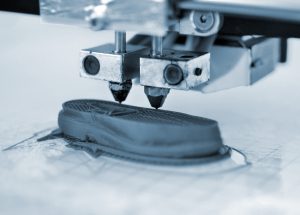Whether it was because of the pandemic or in spite of it, manufacturing technology adoption didn’t stop when the world shifted. Additive Manufacturing (AM) in particular saw continued adoption, albeit at a slower pace.
As an industry, AM grew 7.5% to nearly $12.8 billion in revenue in 2020, as reported by Wohlers Associates. This is much less than the industry average of 27.4% annual growth, but growth is still growth.
Manufacturing services company Jabil recently polled 300 AM decision-makers on a variety of topics related to the use of Additive Manufacturing software products and services. Studying the results reveals emerging trends likely to drive increased adoption of AM processes this year and beyond.
Moving beyond prototyping
Originally 3D printing for manufacturing was referred to as “rapid prototyping” and was the only reason companies were buying 3D printers or outsourcing to 3D printing service bureaus. In 2020, for the first time, the use of prototyping did not rise as a percentage of total industrial 3D printing, while all other uses did.
More companies are now using AM for functional or end-use parts than ever before. Almost 55% of those surveyed by Jabil say they use at  least a quarter of their AM capacity to produce such parts. Companies manufacturing production and management software parts are among the largest users of 3D printing, with many reporting more than 100 3D printers in-house. Companies already using AM beyond prototyping are bullish on increased use; 87% predicted their use will at least double in the next five years.
least a quarter of their AM capacity to produce such parts. Companies manufacturing production and management software parts are among the largest users of 3D printing, with many reporting more than 100 3D printers in-house. Companies already using AM beyond prototyping are bullish on increased use; 87% predicted their use will at least double in the next five years.
HP entered the 3D printing market a few years ago, and is reaping the positive benefits from AM processes under its own roof. The cooling duct in the HP 500 Series 3D printer was originally made from separate pieces. When HP converted the duct to be 3D printed, the separate pieces were consolidated into a single part, reducing production costs by 30%. Other HP divisions took note: the commercial printer division shrunk the part count on the new 12000 Digital Press to only 21 3D printed parts. The company says this resulted in an 80% cost savings and a 91% assembly time reduction.
Supply Chain Challenges
As the use of 3D printing technology continues to increase, so do the challenges related to increased AM production. Manufacturers who actively use AM technology were more likely in 2020 to report scalability issues than in 2019. Issues related to platform technology were up 8% year-over-year, while reported ecosystem issues rose 13%. The AM industry has a long way to go before we have push-button output from a 3D model. There are both proprietary and collaborative open standards under development to make printing a 3D model as simple as printing a PDF file to an ink printer.
The larger issue of digital transformation in manufacturing hits home in Additive Manufacturing. Using AM changes production from a best attempt to achieve design intent to the 100% accurate representation of the design. This is starting to impact supply chains in multiple ways. Some suppliers contribute tools and fixtures, which are eliminated in 3D printing. Others produce a surplus of parts and components for repairs and aftermarket sales. Such warehousing becomes unnecessary when new parts and components can be printed on demand.
Big changes in materials
Plastics are still the most commonly used material for 3D printing, but there is solid growth in the use of both metals and composites. There is also frustration with the current system of most materials being proprietary to one brand or model of 3D printer. 54% of those surveyed say issues with materials prevent their company from using AM more often in production manufacturing.
As materials become more easily accessible and affordable, a green side benefit will increase. Scrap material from traditional manufacturing will be reduced or eliminated. The energy-intensive processes of subtractive manufacturing will be reduced. A study by the Metal Powder Industries Federation compared the process of producing a truck gear by traditional method and by using AM. The traditional way required 17 separate steps; using AM required only six steps. In addition, AM production .
Green is easier said than done
The use of AM to reduce waste is not a panacea, notes Materialise, an AM software vendor and services provider. “If you assume 3D printing is by definition sustainable, then you are greenwashing,” claims Materialise CEO Wilfried Vancraen. Energy use, pre- and post-production issues, and printing waste must all be taken into consideration. “We are strong believers that we can add value in the direction of a more sustainable world, but let’s not fool ourselves. We must do the effort to achieve real sustainability.”
Vancraen cites a lifecycle analysis his company conducted with chemical giant (and major 3D printing materials maker) BASF. They studied a  production run of 1 million pairs of shoe midsoles, recording the environmental impact in all stages of the product life. One production run used three 3D printing technologies, the other used polyurethane casting. The analysis showed that for large volume production of identical products, 3D printing is currently not the most sustainable choice. AM had a bigger impact on climate change and the depletion of fossil fuels compared to polyurethane casting.
production run of 1 million pairs of shoe midsoles, recording the environmental impact in all stages of the product life. One production run used three 3D printing technologies, the other used polyurethane casting. The analysis showed that for large volume production of identical products, 3D printing is currently not the most sustainable choice. AM had a bigger impact on climate change and the depletion of fossil fuels compared to polyurethane casting.
This points to another rising trend, that of finding the best use for both traditional and digital processes. Footwear company Superfeet offers a variety of custom-manufactured products. Using traditional methods they could produce a pair of custom shoes in an hour. When they moved to digital manufacturing and 3D printing, the time to create a new pair of custom shoes dropped to between 15 and 25 minutes.
##
